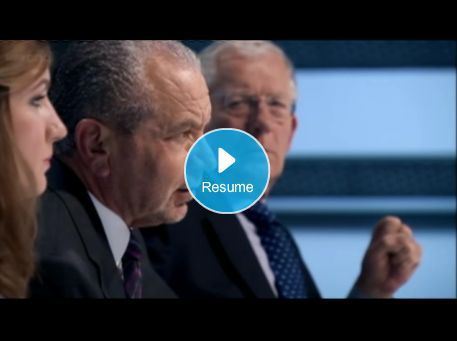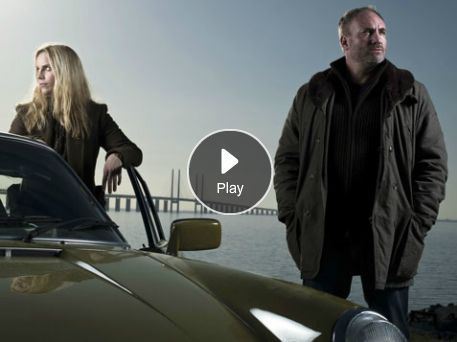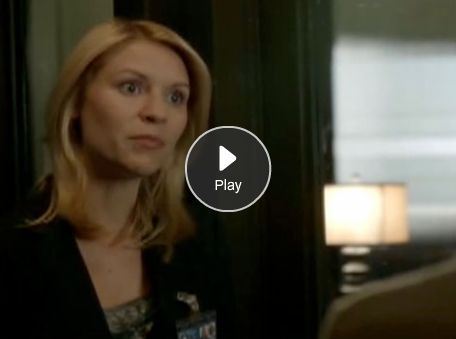Andrew Collins's Blog, page 38
May 8, 2012
Dansk in real life
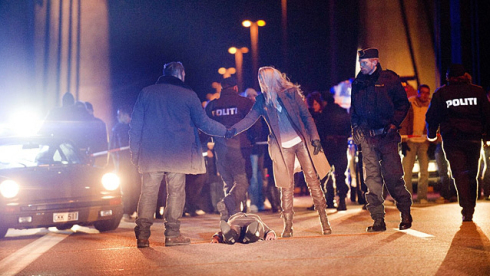
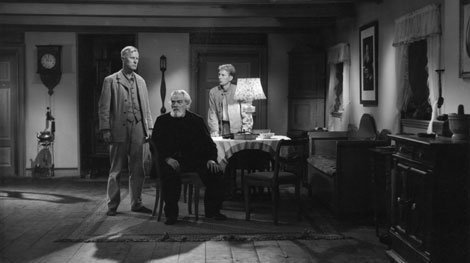
I won’t add to the chorus of approval for Channel 4′s wisely-chosen US import Homeland, which came to a satisfying conclusion at the weekend. Mark Lawson was the latest to have to argue against British TV drama from its long, persuasive shadow in the Guardian on Monday. But for my money, The Bridge, aka Bron in Swedish, aka Broen in Danish, is even better. The latest Scandinavian import to arrive on BBC4 – following Wallander, Forbrydelsen and Borgen – it is surely the perfect encapsulation of what makes the region so fertile in terms of drama and setting. In fact, if you’ve immersed yourself in the Denmark of Forbrydelsen and Borgen, both set in Copehagen and linked by an interest in the politics peculiar to that country, you’ll have a decent head start on The Bridge (which I’ll call The Bridge rather than have to juggle the subtly different Swedish and Danish translations).
I hardly need to go over the set-up, but I will: a body is discovered at the exact halfway point of the elegant, five-mile-long Øresund Bridge, which links Malmö to Copenhagen by road and rail and thus unites two police jurisdictions in solving the crime. (The body, which turns out to be two halves of two separate bodies, has been placed there to get the attention of both, and that’s as far as I’m going to go with the plot, so worry not, those who have yet to catch up, or plan to box-set it.)
It’s as if the dark police procedural of Forbrydelsen has been linked to the more brightly-lit corridors of power of Borgen, mixing social issues with a good old whodunit. In the leads, Kim Bodnia and Sofia Helin create a fabulously mismatched detective duo, one that surely has legs far beyond this one case. Martin Rohde, a rotund, homely, good-humoured, rumpled maverick from Copenhagen is everything that Saga Norén, of Malmö, is not. She’s borderline autistic, socially inept, emotionally stunted, professionally by-the-book, but her powers of deduction are keen and her no-nonsense attitude (and lack of meaningful home life) ensure she gets the job done.
Unlike Sarah Lund, Saga is more overtly sexual in her leather trousers and slash-neck tops (which in the first episode she kept whipping off in the office and changing); she is seen picking up a man in a bar for functional, no-questions-asked rumpo. And yet, she is cold and efficient, and in many ways asexual. Rohde has been emasculated by a vasectomy and feels the need to assert himself sexually but he’s more of a teddy bear. I won’t say how but if there is any sexual tension between them it is subsequently defused in a very surprising way.
There’s real humour in the writing, despite the Gothic nature of the crimes, and much of this emerges in the sparring between Rohde and Norén. There’s also a lot of subtle stuff about the differences between the Danish and Swedish way of doing things – and in the intricacies of language and pronunciation. (This is a Danish-Swedish co-production, a coalition that actually pays dividends, and slices straight down the middle. I mean: can you think of a cleverer pitch than The Bridge in terms of setting out its geographical stall? Usually footage of cars going over a bridge in drama is there to provide a bumper; here, it seems vital. And it’s a beautiful bridge, especially at night against that amazing Scandinavian sky.) We’re six episodes in, with four to go, and all six are available on iPlayer, so get in there if you haven’t already.
I know “Scandi drama” is a phrase that’s tiresomely overused at the moment, and I sympathise if you’re put off by yet more Guardian-reader hype, but even Radio Times got onboard this time, putting the completely unknown Helin on the cover (and unrecognisable in the pic they used), and The Bridge drew over a million to BBC4 in its first week (more than The Killing), which is hard to argue with. I find the bendy sound of the Danish and Swedish language to be easy on the ear, and I guess I’m used to it, having previously organised my own home-schooling crash course in the works of Ingmar Bergman. About ten years ago, when his back catalogue started to come out at a rate of knots via Tartan, I eagerly got up to speed, and titles like Winter Light, The Silence and Wild Strawberries became instant all-time favourites.
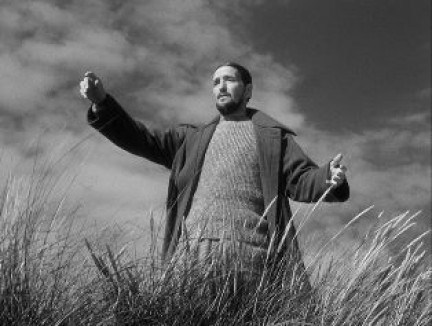
At the weekend, I went to the Curzon Chelsea to see Ordet on the big screen, my first taste of Carl Theodor Dreyer, the father of Danish cinema and often cited as one of the greatest directors of all time. I feel a little late to the party, but what a way to start! Ordet (The Word) is one of his later films, made in 1955, when Bergman was enjoying his first international hit with Smiles Of A Summer Night. Dreyer had made his name in the 1920s, helping to forge the medium. I must now delve into that early work – notably The Passion of Joan of Arc and Vampyr (which I’ve always been aware of, thanks to all the history of horror books I used to devour as a boy), and what I know to be his 1940s classic Day of Wrath. I loved Ordet. It is utterly captivating; hypnotic stuff.
Based on a 1932 play, although I assume the film is set in the 1950s, it has a theatrically staged feel, with characters standing in rows, coming in and out of doors, and enunciating very precisely and slowly against flat backdrops, but it opens melodramatically on location in the dunes around a rural farm, where the haunting character Johannes (Preben Lerdoff Rye) who has gone insane and thinks he is Jesus Christ, declaims to what he considers to be a Godless universe. The rest of the Borgen family – yes, you may spot links between Ordet and the previously mentioned modern Danish culture – find themselves caught between God and science, tradition and progress, birth and death, true faith and cold, hard reality. They also come into conflict with a neighbouring evagelical Christian sect, for whom faith is grim and joyless, while the Borgens’ is about warmth and celebration. (Having said this, it’s all relative, and the Borgens are not exactly dancing around the place, flinging flowers in the name of the Lord.)
It’s mesmerisingly slow and deliberate, and everybody seems to walk at the pace of Frankenstein’s monster, and if this is what Danish theatre was like in the 1930s, I want to go there. It’s been hailed as a masterpiece, and I can see why. Not only is the subject matter profound, and heart-stopping at one crucial juncture (which I won’t ruin), but, again, there’s humour here. Surely Dreyer was anticipating a laugh from the audience when Johannes’ condition is explained by his father (Henrik Malberg) to a visitor who assumes it was “love” that sent him mad, but in fact, he explains bluntly, “It was Kierkegaard.” (It’s a gag worthy of Woody Allen.)
Unlike Peter the Tailor in Ordet, I’m not here to convert anybody. This kind of cinema is not going to be for everybody. I would understand if you found it irritating and punishing, and that you found Johannes comical – which I feel sure he’s not meant to be, and anyway, it haunted me. I just find myself with a real urge to soak up Danish culture. Denmark is a foreign country. They do things differently there.

May 4, 2012
I’m hired
I hope. This week’s Telly Addict represents my first birthday. I am one. Happy birthday to me. This is the 52nd Telly Addict that has gone out into the world. Alright, 53rd, as the lively and hardworking Guardian contributor Stuart Heritage did it for one week when I was away. (I won’t make that mistake again. It’s a doggy-dog world etc.) But it’s been a year for me, so … as well as randomly reviewing Week 7 of The Apprentice on BBC1; Foxes Live on C4; and the delectable Grandma’s House on BBC2, there’s an intricate “previously on …” montage, which I hope you enjoy. And congratulations to Cameron Robertson, who I believe is the heroic soul who edited it together. (See how I credit other people?)

London’s rubbish

It’s not. London’s Rubbish was the title of a spoof of London’s Burning Stuart Maconie and I wrote for our first radio series in 1993, which – and this is pretty clever – instead of the fire brigade centred around the capital’s refuse collectors. (We were, historians will note, a year ahead of Common As Muck, William Ivory’s BBC comedy drama about binmen.) Although I was a permanent resident of London in 1993, Stuart lived in Birmingham – as indeed he still does – and had a more circumspect relationship with our glorious capital than I. Having spent my first 19 years in Northampton – a town I have a strong emotional bond with, and where the bulk of my family still reside – I fell for London within six months of emigrating here in 1984. I have never wished to live anywhere else. Except for Galway.
The important thing to note, on the day that the results of London’s Mayoral and Assembly elections come in, is that when I arrived here, in the mid-80s, all fired up by the left-wing politics of the NME (which provided me with a much-needed political education after indoctrination in Tory selfishness from my Dad), Ken Livingstone ran the place. Under siege from Margaret Thatcher’s ideological hatred of “Loony Left” policy, for which he was a lightning rod, and the public sector in general, his GLC was both a beacon and a blot on the landscape. It would be disbanded within two years after the Local Government Act of 1985. (ILEA, the Inner London Education Authority, which controlled the art school I went to, was also on the block, dissolved in 1990. Its decision to amalgamate the four London art schools in 1985 lit the spark under my first student demo, which took us to County Hall, Ken’s home, with our hand-painted placards.)
Because of the turbulent times, and a conversion to Labour that led me to joining the party in time for the 1987 General Election, I have only positive memories of “Red Ken.” He introduced “Fares Fair”, which reduced public transport costs through subsidy, proposed a statue of Nelson Mandela, and – whatever your feelings on the issue – was bold enough to conduct a dialogue with Sinn Féin’s Gerry Adams in 1982, which was exactly what New Labour did some years later but was considered in poor taste at the time. The right-wing press was full of nonsense about the “Loony Left” and it would have been easy to get sucked into it, but my memory of Ken is one of admiration and a feeling that he was on the side of ordinary Londoners.
By the time of the 2000 Mayoral elections, Ken was out-manoeuvred by the Blair government and forced to stand against the Labour candidate, Frank Dobson. Again, I cheered him on, being well past the honeymoon period with Blairism and gung-ho for anyone who’d stand up to Blair. I voted for him. That he won seemed a moral victory as well as one for common sense. (He’d run London before; he was well qualified to do it again.) By the time of the 2004 Mayoral elections, he was readmitted to Labour, and I voted Green. Same again in 2008, by which time, unfortunately, a reinvigorated Conservative party had shrewdly fielded lovable TV buffoon Boris Johnson, and he swept Ken aside.
I would say, as a London resident, that the biggest issue is always public transport. Ken froze bus fares when he first got in, and introduced the Oyster swipe card to reduce queuing and delay on buses and trains, which definitely had the desired effect. It meant that travellers without an Oyster had to pay more per journey, which was seen as a disadvantage for visitors. I was against Oyster for years, mainly because I didn’t want to be electronically tagged every time I used a bus or Tube, but I gave in, as it was so financially advantageous to pay this way.
Ken introduced the infamous “bendy buses”, which because of their length were easy to sneak onto, wreaked articulated havoc on other drivers, cyclists and pedestrians, and some of them caught on fire, and these have since been scrapped by Boris. But Ken was always against the Public Private Partnership as a way of regenerating the Underground, a point on which he and I agreed. He was also powerless to stop it going through, and, I think, unprincipled enough to still rejoin Labour when they courted him. Fares, especially for those commuting in from the outer reaches of Greater London, have shot up under Boris. Whether Ken could have stopped this, I don’t know.
The results are not yet in. Because of the make-up of the Assembly, and proportional representation, it’s actually worth voting Green, as you can actually place them in power. There are two Greens on the Assembly as I type. This pleases me. So, pretty much physically unable to put a cross next to “Labour” yet (the scars of betrayal are still weeping), I voted for Jenny Jones, the admirable Green candidate. You get a second choice, so I was forced to put a cross next to Ken, as a protest vote against Boris. (I almost bumped into him on the campaign trail in 2008 in a high street in South West London, and a schoolboy shouted out, as he passed, “Boris Johnson’s got a big fat head.” I admired this boy for his astute political observation – and the fact that he didn’t swear.)
I like going out to vote. I like clutching a polling card. I find it a novelty to walk into a church hall, which is not something I would normally do. I like to think I was one of the first to cast my vote yesterday morning, popping in at 7.10am on my way to get the paper. I don’t imagine my first- or second-choice votes really made a difference, as Londoners seem more invested in the cult of Boris (and perhaps a historical distaste for “Red Ken”) than in the party he stands for – a party who are surely close to being discredited forever nationally? I have a lot of time for Liberal candidate Brian Paddick, but the Liberal Democrats are as dead to me as the Tories.
I think what I like about elections is that they focus your mind. It’s all very well shouting at the news and throwing your newspaper down in disgust, but on a daily basis, you are powerless to do anything more meaningful about it. On election day, you get a cross, or four crosses in the case of yesterday’s.
London is a huge city with massive problems. We’re currently looking down the barrel, literally, of the Olympics, which promise to bring the place to a halt for weeks. (There are helpful posters up all over London advising us to leave for work earlier or later, or stay at home, or walk to work, or cycle, or if that’s not feasible just go and fuck ourselves, during the games.) It takes three hours to get into the place by airport. There are missiles mounted on a tower block in East London. The local paper, the London Evening Standard, is now almost totally given over to propaganda about the Olympics, and has been a parish magazine for Boris, who thinks that earning £250,000 a year for a newspaper column is “peanuts”.
As I publish this, he’s in the lead. I am delighted to see that Jenny Jones is ahead of Brian Paddick, as that feels like a slap in the face for the party that seems happy to act as David Cameron’s houseboy.
Whoever gets in, London will continue to be dirty, overcrowded, dangerous and slow, and the Tube will continue to fall to bits. But I wouldn’t want to live anywhere else. Except Galway.

May 2, 2012
Trouble downstairs
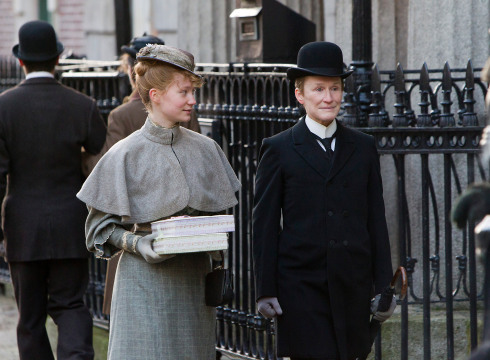
After all the Oscar and Golden Globes heat, I was looking forward to seeing Albert Nobbs, despite my sentimentality needle going into the red every time I saw the trailer. I remember this film with the weird name standing out of the speculative longlists during the first flush of “Oscar buzz” at the start of the year as it was pretty much the only one I didn’t recognise. I was quickly up to speed: it was the one in which Glenn Close plays a man.
Albert Nobbs is a woman in 1890s Dublin who has adopted the persona of a man in order to get better-paid work. Or at least, that’s what I took away from it. She is also a lesbian, although a repressed one who dreams less of getting it on with another woman, than settling down in respectable marriage with one, so that she can be the husband. Working as a waiter in an upmarket hotel, run by Pauline Collins, one of the few non-Irish actors in the film who manages a decent Irish accent, Nobbs – prim, proper, upright, stiff, reticent, deferential, all those things – meets Janet McTeer’s painter and decorator, a man who also turns out to be a woman in disguise. Except McTeer – who steals the film from under Close’s prim, proper etc. nose – has a wife. We see the couple at home, a lesbian couple who must maintain the dressing-up-box pretence of heterosexuality even in their front room, in case a neighbour should walk past the window.
Now, I know what you’re thinking – apart from: what are the chances of two cross-dressing lesbians in male professions meeting up by pure chance in 1890s Ireland? – this sounds like an original and interesting premise for a period drama. A landmark in “Queer Cinema” but, like Brokeback Mountain, disguised as mainstream entertainment. What a wasted opportunity it turned out to be.
The film’s backstory is far more interesting than the film itself. Based on a 1918 novella by James Joyce-influencing writer George Moore (published in 1927), Glenn Close played the role in a stage adaptation in 1982 and has been trying to bring it to the screen ever since. It’s a passion play for her. And you have to admire her tenacity. The trouble is, if was shocking in 1927, and still a bit shocking in 1982, it’s just not shocking at all in 2012. Indeed, it’s all rather quaint. Directed by Rodrigo Garcia (son of Gabriel Garcia Marquez!) in flat, muted colours and at a stately pace, it has the feel of a Sunday night episode of Upstairs Downstairs or something by Catherine Cookson.
It’s a 15 certificate, but needn’t be. At one stage McTeer flashes her breasts at Close as a big reveal that I’m afraid we all saw coming, even if Albert Nobbs didn’t, and Brendan Gleeson is seen going down on Maria Doyle Kennedy, but under the sheets. Beyond that, it’s a U. Not that it needed sex; after all, Nobbs, despite his name, is very much above the belt. But it could have done with a bit more lust, or a bit more colour in its cheeks. It opens so well, with a fabulously mixed parade of hotel guests trooping into Pauline Collins’ formal dining room, including the always-brilliant Gleeson, a gay dandy played by Jonathan Rhys Myers (he gets two scenes in the whole film), and servants fleshed out by the talented likes of Mark Williams, Antonia Campbell Hughes, Mia Wasikowska, Brenda Fricker and the aforementioned Doyle Kennedy.
Such a lot of acting talent to so slender an end. Aaron Johnson is the handyman with eyes for Wasikowska, and their affair is supposed to engage our interest, but doesn’t. (Johnson’s accent is possibly the worst on screen.) She was perfectly ornate in Alice In Wonderland and I bought her as a modern teen in The Kids Are All Right, but Wasikowska fails to breathe life into her mousy maid. Doyle Kennedy and Gleeson are onscreen not enough, and Rhys Meyers hardly at all. The interiors are claustrophobic – all poorly lit corridors and pokey bedrooms – but when we go outside, the period streets scenes were clearly limited by budget, and little air blows through.
I didn’t hate it or anything. There’s not much in it to like, or dislike. Close’s performance, hobbled by an inconsistent accent, is delicate and precise, but Nobbs is hard to understand, she comes across as a cipher, an otherwordly figure who rarely laughs or comes alive. I’m sure this is true to the text, and the play, but far from complex, she’s a bit like Forrest Gump in a bowler hat.
I emerged from the cinema underwhelmed. I wonder if others, tempted by the Oscar buzz, felt the same? It should have been the performance of Close’s career – and some kind souls said it was – but if Robin Williams had played it, and facially he could have, Nobbs might have pulsed off the screen rather than remain skulking in the background.

April 30, 2012
Hey ladies
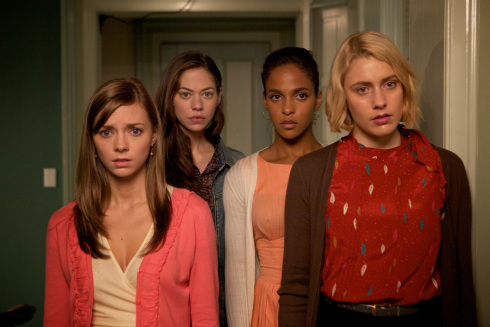
By accident and not design, I saw two films at the cinema over the weekend that were about women. The first, Damsels In Distress, written and directed by a man, portrayed men in a very bad light; largely as thick-headed, arrogant dimwits or shysters. The second, Elles, written and directed by a woman, also portrayed men in a bad light; as desperate, shallow sad cases, sometimes cruel with it.
The first, and more successful, was Damsels In Distress. American indie auteur Whit Stillman takes his time. He’s only made four films since 1990. The first two, which I haven’t seen, were linked by low budgets, no stars, lavish praise and a concern for the urban haute bourgeoisie, Metropolitan and Barcelona. I’d like to see them. I saw The Last Days Of Disco in 1998, the third part of a loose trilogy apparently, because I was tempted by the subject matter, and I remember really enjoying it. It also revolved around two women.
Disco was set in the early 80s. Damsels is set now. Or, at least, I think it is; there are few clues that time has passed much since the 1950s, and because it’s set in a minor, fictional Ivy League college where the puzzling culture of fraternity houses still holds primitive sway, it all seems very remote and old-fashioned. That is, I’m sure, the point. (There is a subplot about the frat houses being closed down.) When I saw National Lampoon’s Animal House in 1979, aged 14 – it was my first “AA” – this was my first exposure to the arcane college system of the United States, and I wasn’t worldly enough to spot that it was set in the early 60s. I realise that now, just as I realise that Happy Days was set in the 1950s, which I didn’t at the time. America seemed so foreign when I was a kid, I assumed it was still all about milk bars and the hop. Which, of course, to an extent, it still was in the 70s, and to a lesser extent, still is today.
Greta Gerwig is the only recognisable face. As Violet, she leads a group of prissy girls whose stated mission is to “save” dimwitted boys by going out with them and seeking to improve them. It’s a bizarre almost sexless set-up, but Stillman plays it so straight, it’s hard not to be drawn into this parallel universe. Nobody speaks as people speak; they are all dazzlingly eloquent and self-aware, and you will either find this a delight, or a massive irritant. I fell almost immediately into the former camp. If someone told me they couldn’t even sit through it, I would empathise.
It’s a 12A. There’s nothing in Damsels to frighten the horses. One subplot hints that a boy – duplicitous and untrustworthy, naturally – elicits anal sex with one of the prissy girls by claiming it’s a religious necessity for him, but this is as close to adult the film gets. It’s sort of the anti-Heathers. Gerwig’s troupe, who run a suicide prevention centre and offer tap-dancing as a therapy, seem brittle, remote and untouchable at first, but reveal deeper human feelings as the story progresses, even depression, all of which are whipped back into a fluff by an ending that comes as something of a shock, albeit a feelgood one.
It’s rare you see a film that reminds you of little else. Damsels is one such. (I gather it reminds people who’ve seen them of, yes, Metropolitan and Barcelona, the first of which was also concerned with an Ivy League college; Stillman went to Harvard.) It’s clever, wordy and weird, and if it puts women on too high a pedestal – and casts men into such a corresponding trench – well then, hooray for Whit Stillman. Better his breathless praise for the opposite sex, than Polish director Małgorzata Szumowska’s apparent disdain for her own, as we are about to see.
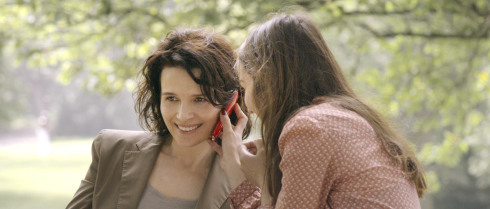
I’d read some lukewarm and hostile reviews of Szumowska’s French-language reverse-porn film Elles before seeing it, and such reviews are rare for anything with Saint Juliette de Binoche in. She plays an almost totally implausible journalist for Elle magazine, the kind who sits at home in her gorgeous Paris apartment staring at a computer and fielding calls about word-length from an unseen editor. (It may have been sloppy subtitling, but at one stage, she and the editor haggle over 8,000 “characters”, which must surely have meant words?) She interviews two female students who work as prostitutes to supplement their fees, and in doing so, unlocks her own inner prostitute. Not literally, of course, but that seems to be the thrust of the story.
It’s tosh. The studes, one French, Charlotte, one Polish, Alicja (hey, the director is Polish and she’s making her first French film, who can blame her?), seem not just guilt-free about servicing “bored husbands” for Euros, but empowered by it. They are certainly no damsels in distress. I may have missed a few meetings since becoming a feminist in the 80s, but the empowerment of women through submission to male needs and fantasies has always been a thorny one for me to grasp; clearly, women should enjoy nothing less than equality in all areas of life, from work to sex, but I’m not modern enough to see how pole dancing fits into this.
Anyway, Elles (rotten title) revolves around Binoche’s superwoman preparing a slow-cook casserole for her blasé husband’s boss, juggling the kids (including a particularly nightmarish teenage dopehead son), going food shopping and trying to fix the fridge door, while also attempting to finish her article, which chiefly involves listening to interview tapes that provide us with flashbacks mostly of the two students having frank sex with various men. Their clients run the clichéd gamut: from the businessman who bursts into tears after a premature ejaculation, to the shark in the hotel room who turns out to be a disgusting sadist (a rare instance of momentary distress there, but not enough for Charlotte to consider putting a stop to her extracurricular revenue stream). The only character who seems new is the middle-aged bloke who serenades his prostitute, naked, on an acoustic guitar. Was this odd moment of comedy supposed to show that not all men who pay women for sex are bad? That rather lets them off the hook, doesn’t it?
Although the sex is not titillating – or at least, not titillating unless you are titillated by seeing bored young women service older men – there is a lot of it, and I’m not sure it added much to the already fairly thin thesis. In the end, I found Elles infuriating, which wasn’t helped by the couple sitting next to me who had sought out the Noisiest Snack Available in the foyer and kept talking until I politely asked them not to.
I didn’t buy it. Binoche is literally never bad; and she gave the part her all – an “all” it didn’t really merit – imbuing a cardboard cut-out with life and radiance. But her grown-up journalist seemed to find the whole subculture of prostitution so shocking, you started to wonder if she’d ever read a newspaper article in her life. The scene where she gets drunk with the Polish student and they indulge in a sort of semi-erotic, quasi-Oedipal display of dancing to a terrible electro track is particularly embarrassing, and if it had been conceived by a male writer/director, you could have put it down to sleazy voyeurism. But it wasn’t.
Perhaps Elles is simply intended to be a protest about student fees. But a film about bar work isn’t really going to get the punters in, is it?








April 27, 2012
I could murder a Danish/Swedish
This week’s Telly Addict, which features a new jacket (rain-spattered on the walk up to the Guardian from the British Library, but hopefully you won’t notice), covers many things: The 70s on BBC2; The Bridge on – where else? – BBC4, or BBC-SvedeDansk as I think we should all call it; Four Rooms on C4; Two Greedy Italians on BBC2; and Smash on Sky Atlantic, which turned out to be the first bum note in the channel’s short history.

April 23, 2012
Something in the water
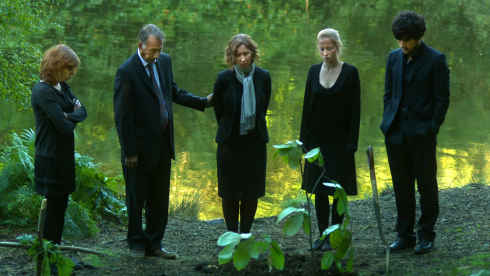
You may have read or heard about Black Pond, the proper-indie British black comedy that was made for £25,000 (next to nothing in budgetary terms) and shot over three weeks by first-time, twentysomething writer-directors Tom Kingsley and Will Sharpe, as it earned them a Best Newcomers Bafta nomination, the London Comedy Film Festival Discovery award and the Evening Standard Film Award for Best Newcomers. I also read about it when it came out last year, but didn’t see it. My former Radio 2 patron Zoe Ball – who is a Bafta member – saw it and was raving about it, so when I noticed it being reviewed as a DVD, I Tweeted the film’s Twitter account to inquire who was doing its publicity.
Tom Kingsley himself emailed me back and said that he and Will were. This is a low-budget film, after all. Who can afford to take on a PR company? I asked if I could borrow a copy to watch, and he very kindly sent me one to keep. With all that positive hype and a layer of kindness spread over the top, I suddenly felt a terrible pressure to like it. God, what if I didn’t?
I did. It’s brilliant. It’s recognisably a British take on suburban, middle-class manners and media exploitation, and the familiar if unusually-cast faces of Chris Langham and Simon Amstell also give you something to go on (albeit, in the case of Langham, a strange feeling of unease, too), but Black Pond is not your average film. It is framed by interviews with the fractured and fractious family of four, the Thompsons: Langham’s dad Tom, Amanda Hadingue’s blocked poet mum Sophie, and their two daughters, Katie and Jess (Anna O’Grady, Helen Cripps), who seem collectively to have been accused of the murder and burial of a man at the local Black Pond where the parents still live in Surrey, minus the two girls, who have flown the nest and emigrated to London.
The rest is told in flashback. We might know about the murder from the outset, but I’m still alarmed by how much of rest of the plot was given away in a lot of the reviews when it came out in November (rave reviews, incidentally, with five stars from the Financial Times, and four from the Times, Guardian, Independent, Telegraph, Express and Total Film). I’m going to remain cagey, other than to say, the arrival of needy but seemingly harmless stranger Blake (Colin Hurley, who seems previously to mainly have been in The Bill and Casualty, but what a find!) is key to the unfolding events.
Will Sharpe also plays the daughters’ besotted flatmate Tim, who, following the murder, sees an eccentric, cruel and self-serving shrink, played in his first film role by Amstell, who has a great time and provides Black Pond with its only overt comedy. I found myself laughing, too, at a frustrating conversation between Tom and Sophie in bed about whether or not it was a good idea to eat a banana in order to get back to sleep (“Sheer lunacy!” concludes Tom). It’s not that we’ve forgotten that Langham is a beautifully nuanced and naturalistic comic actor, merely that I think we’d got used to the idea that we wouldn’t be seeing him on our screens again.
Whichever way you slice his unfortunate backstory, he’s done his time, and made a fairly compelling case for why he committed his crime. That said, his presence adds to the strangeness of the film, which has an astonishingly compelling dream sequence that is fuelled by imagination and DIY special effects, and some animations that involve child-like drawings brought to life in crude, two-frames-a-second style. All this adds to the cumulative creepiness of the story, which lurches from Mike Leigh-style domestic awkwardness and comedy of leafy squirmsmanship (a sort of Archipelago goes to Weybridge), to moments of eerie darkness. The presence of a three-legged dog, Boy – played, animal lovers, by Bonzo – adds to the atmosphere of something not being quite right.
You’re aware that it’s a make-do-and-mend operation, but I’d rather see Black Pond than any number of over-budgeted “indies” that in fact parade their Hollywood production sheen with something approaching inverted snobbery. (Take This Must Be The Place: notionally independent in spirit and pacing, it has amazing, stunningly-shot New Mexico landscapes, but what is its medium budget really bringing to the narrative other than spectacle?)
This is Black Pond‘s website. It’s not worth your time just because it’s a first film, and made on the cheap, it’s worth your time because it’s great.

April 22, 2012
Together again, at last
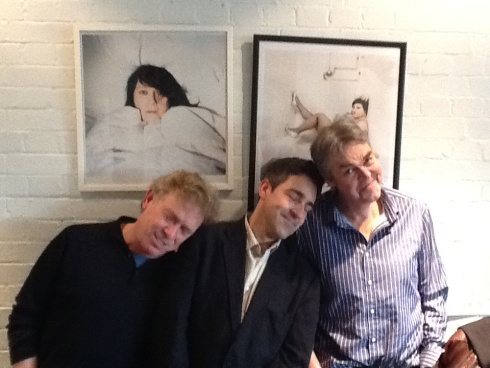
After a punishing 14 months in the wilderness, I was called up for prattling duty on the Word Podcast on Friday. It’s available here. I don’t mind telling you: I asked. As what a rare treat it always is to shoot the breeze, trade quips and occasionally draw breath with David Hepworth, Mark Ellen and Fraser Lewry (who took the pic above). We covered all sorts, including Marley (which I hadn’t seen on Friday), Levon Helm’s name, the intricacies of Christopher Guest, South-East Asian cuisine and … sorry, I’ve just remembered, you have to be a Word subscriber to hear the whole thing, but there’s a free 15-minute taster for all. Why wouldn’t you subscribe to Word anyway? You can do that here. Tremendous value, tons of benefits etc. Not only would you be helping to keep a thinking person’s monthly magazine of the old school alive – one that’s published by a small, independent publisher, lest we forget – you’d be allowing middle-aged men (and one younger woman) like these the opportunity to exchange hoary old rock anecdotes and dismiss entire modern conventions with the phrase “all that palaver” in a cupboard on a weekly basis.
Incidentally, the photo above refers to a story Mark tells about Lucinda Williams. I won’t spoil it.

Marley & I and I

In an effort to be the most clichéd white person in the country, I am listening to Bob Marley on Spotify as I type, inspired to do so by having seen Kevin Macdonald’s splendid two-and-half hour documentary Marley. I’m glad I saw it at the cinema on a Saturday afternoon, not just because it put a massive smile on my face, but because there’s still something thrilling about watching footage you expect to see on TV on the big screen, such as the all-too-scant concert footage of Marley that snakes vitally through the film, a film that is otherwise dominated by interviews and actuality from modern-day Jamaica, where most of his compatriots and offspring still reside.
I’ve been seeing the trailer for Marley for weeks at the Curzon – again, I can almost recite it – but unlike similarly overplayed ads for The Kid With A Bike, Blackthorn and Le Havre, there’s not much you can ruin about a hagiographical lifestory. After all, we know Bob dies at the end. (Having glibly said that, the details of his final months were incredibly moving and sad, especially when, at a snowbound Bavarian holistic clinic, his dreadlocks fell out and we heard from his daughter Cedella the shock she felt when she saw him, looking small for the first time in his life: the lion without his health-giving mane. Incidentally, the cancer had riddled his body by the time he went to Germany for a treatment based on nutrition, but I couldn’t help thinking: this is not a man who should be somewhere cold and snowy in his last days. He eventually died in Miami.)
When a figure from music is so big, so widely hailed, so iconic, and his music has been so comprehensively absorbed not just into the mainstream but into the fabric of our lives, it’s easy to take him for granted, but Marley re-establishes Bob Marley as the true one-off he surely was, raised as a “half-caste” in dirt-poor Jamaica, driven by music from an early age, immersed not just in the local music – Mento, ska, then reggae – but in the particular religion of his island community, and yet, accepted and loved by every creed and colour around the globe.
Although this is very much sanctioned by his estate, and co-produced, seemingly, by most of the people interviewed for it, Bob is not entirely sanctified. He was, to use Mark Ellen’s phrase, a “tremendous crumpeteer”, and left behind 11 kids and no will. That said, he did seem to genuinely believe in a higher power than money, something that laid him open to all sorts of opportunism. I felt that Chris Blackwell – another co-producer – was given short shrift, with barely a mention for the important part Island Records played in bringing Marley, and thus reggae, to a wider (for which read: whiter) audience. At one stage, the voice of Peter Tosh is heard, referring to Blackwell as “Whitewell.”
My knowledge and appreciation of reggae used to be fairly vanilla, but when my first 6 Music show was produced by the MOBO-lovin’ Frank Wilson, my understanding of reggae’s roots in ska and rocksteady, and before that imported American R&B, was deepened. I also interviewed the writer David Katz, whose 2004 oral history Solid Foundation is a great, well, foundation, and photographer David Corio, another white man captivated by Jamaican culture. I was also lucky enough to meet Rita Marley, whose book No Woman No Cry gives an honest, up-close account of Bob’s antics. All of this matured my view, and I took away a love for early reggae in preference to the big stuff Marley was shaking the world with in the 70s. (I prefer to hear The Wailing Wailers – Judge Not, Simmer down – featured in the film, and have a soft spot for tinny late-60s stuff like The Paragons, The Pioneers, The Upsetters, Desmond Dekker.)
So, go and see the film. Witnesses like Bunny Wailer, Neville Garrick, Junior Marvin, Ziggy, Carlton Fraser, Aston Barrett, Allan Skill Cole are so charismatic, you just love being in their company as the story unfolds. It’s astonishing how little moving footage there seems to be of Bob, in concert or otherwise, and many of the big moments are captured only in stills. But whole episodes of his life were unknown to me, particularly the concert in Zimbabwe with the tear gas; and the massive shows in America where very few black people turned out, leading to the support slot with the Commodores – something Marley was honest and humble enough to do – where at last he and the Wailers see black faces in the crowd. Segregation may have been officially banished in the US, and in the former Rhodesia, but still dividing lines were drawn.
I’m not sure to what extent Marley is Macdonald’s film, as he seems to have taken up the reins after previous director Jonathan Demme fell out with one of the producers, but it sounds like a soft Scottish accent asking many of the questions off-camera, so I’m hoping it’s him. The skill in putting one of these things together is partly to “animate” stories where only testimony and still photographs exist, but partly to link the present with the past. With a subject whose legacy seems set to loom in perpetuity, at least there’s no danger you’ll end up on a nostalgia cruise.
Just as watching French and Italian films always makes me want to drink wine, watching Marley might have you reaching for the cigarette papers. Not in the cinema, though, please.
For the record and full disclosure (I am nothing if not scrupulous in these matters), this blog post, hardly an inflammatory or controversial one, originally contained a joke which I removed last night once it had come to intention via Twitter that it had been taken at face value. Mea culpa: it was obviously a bad joke, badly made, and I immediately edited it, as it had no bearing whatsoever on the sentiment of the review. It was a daft reference in the bit about Bob’s failed holistic treatment to Ben Goldacre and Robin Ince that was certainly never intended to offend. If anything it was a joke about our famous differences of opinion, as much a joke on me as them. After all, Robin is my friend, and I have met and worked with Ben on a number of occasions, thanks to Robin, and it has always been civil and even jokey. Anyway, I think some of the latter’s followers on Twitter must have linked to the site, as for a fairly unremarkable review of a film, it’s had an unusual amount of visits. If you posted a comment questioning the joke and your comment hasn’t appeared, it’s because I removed the joke. Apologies for any confusion, although not to anyone who tried to turn it into a fight. (I do not have a smart phone, and am “off Twitter” and “off blog” for hours at a time, especially at weekends, so I am sometimes slower to respond to these things than other people.)

April 20, 2012
Spoiler Alert!
I mean it. This week on Telly Addict, I’m trying something new: reviewing not the fanfare-and-fireworks-display beginning of programmes, as is traditional, but the end. So, it’s the conclusion of ITV1′s Titanic; the conclusion of BBC2′s White Heat; and a catch-up with C4′s Homeland at about two thirds of the way through. It’s an experiment, but, I hope, a useful one (especially as the first two turned out better than I’d expected, and you can’t always say that about a series). Either way, if you’ve yet to see any of them up to – respectively – episode 4, episode 6 or episode 9, I warn you now, there will be things about how they end. Insert joke about the Titanic sinking here. I know I did.

Andrew Collins's Blog
- Andrew Collins's profile
- 8 followers


